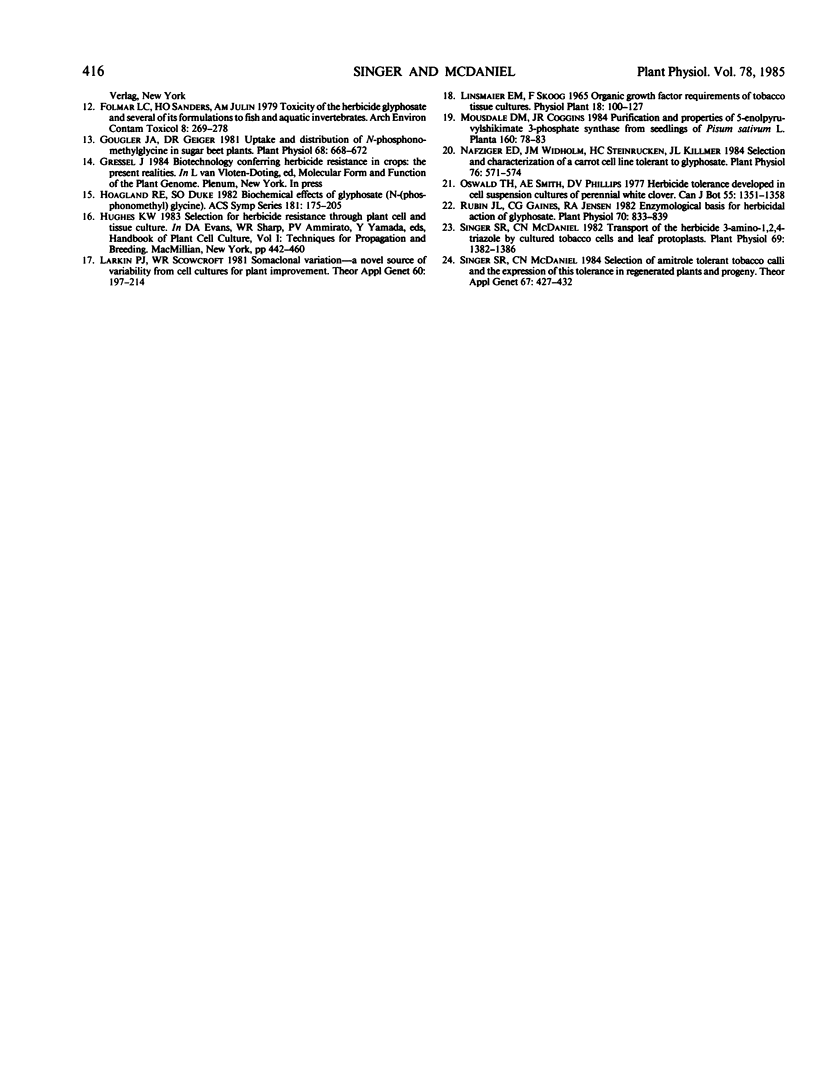Abstract
From nonmutagenized haploid suspensions of Nicotiana tabacum L. cv Wisconsin 38 cells, 51 cell lines capable of growth in the presence of 1 millimolar glyphosate (N-phosphonomethyl glycine) were initially isolated at a frequency of 2.3 × 10−8. Eighteen cell lines retained tolerance when grown on selective medium for 3 years. Tolerance persisted for at least 14 months in six cell lines cultured in the absence of glyphosate. Some plants regenerated from four glyphosate-tolerant cell lines were tolerant. Glyphosate-tolerant tissue was isolated from some sensitive as well as some tolerant regenerated plants. Six of the tolerant cell lines were also tolerant to the herbicide amitrole (3-amino-1,2,4-triazole). Five cell lines selected for amitrole tolerance were glyphosate tolerant. Some plants regenerated from three of these five cell lines were glyphosate tolerant and glyphosate-tolerant tissue was obtained from several of these regenerated plants. Amitrole uptake in suspension cultures of several variants was assessed in terms of influx rate constants. This parameter was not sufficiently different indicating that altered membrane properties could not account for the herbicide tolerance.
Full text
PDF





Images in this article
Selected References
These references are in PubMed. This may not be the complete list of references from this article.
- Blackman M. S., McDaniel C. N. Amino Acid Transport in Suspension-cultured Plant Cells: II. CHARACTERIZATION OF l-LEUCINE UPTAKE. Plant Physiol. 1980 Aug;66(2):261–266. doi: 10.1104/pp.66.2.261. [DOI] [PMC free article] [PubMed] [Google Scholar]
- Chaleff R. S., Ray T. B. Herbicide-resistant mutants from tobacco cell cultures. Science. 1984 Mar 16;223(4641):1148–1151. doi: 10.1126/science.223.4641.1148. [DOI] [PubMed] [Google Scholar]
- Folmar L. C., Sanders H. O., Julin A. M. Toxicity of the herbicide glyphosphate and several of its formulations to fish and aquatic invertebrates. Arch Environ Contam Toxicol. 1979;8(3):269–278. doi: 10.1007/BF01056243. [DOI] [PubMed] [Google Scholar]
- Gougler J. A., Geiger D. R. Uptake and distribution of N-phosphonomethylglycine in sugar beet plants. Plant Physiol. 1981 Sep;68(3):668–672. doi: 10.1104/pp.68.3.668. [DOI] [PMC free article] [PubMed] [Google Scholar]
- Nafziger E. D., Widholm J. M., Steinrücken H. C., Killmer J. L. Selection and characterization of a carrot cell line tolerant to glyphosate. Plant Physiol. 1984 Nov;76(3):571–574. doi: 10.1104/pp.76.3.571. [DOI] [PMC free article] [PubMed] [Google Scholar]
- Rubin J. L., Gaines C. G., Jensen R. A. Enzymological basis for herbicidal action of glyphosate. Plant Physiol. 1982 Sep;70(3):833–839. doi: 10.1104/pp.70.3.833. [DOI] [PMC free article] [PubMed] [Google Scholar]
- Singer S. R., McDaniel C. N. Transport of the herbicide 3-amino-1,2,4-triazole by cultured tobacco cells and leaf protoplasts. Plant Physiol. 1982 Jun;69(6):1382–1386. doi: 10.1104/pp.69.6.1382. [DOI] [PMC free article] [PubMed] [Google Scholar]



